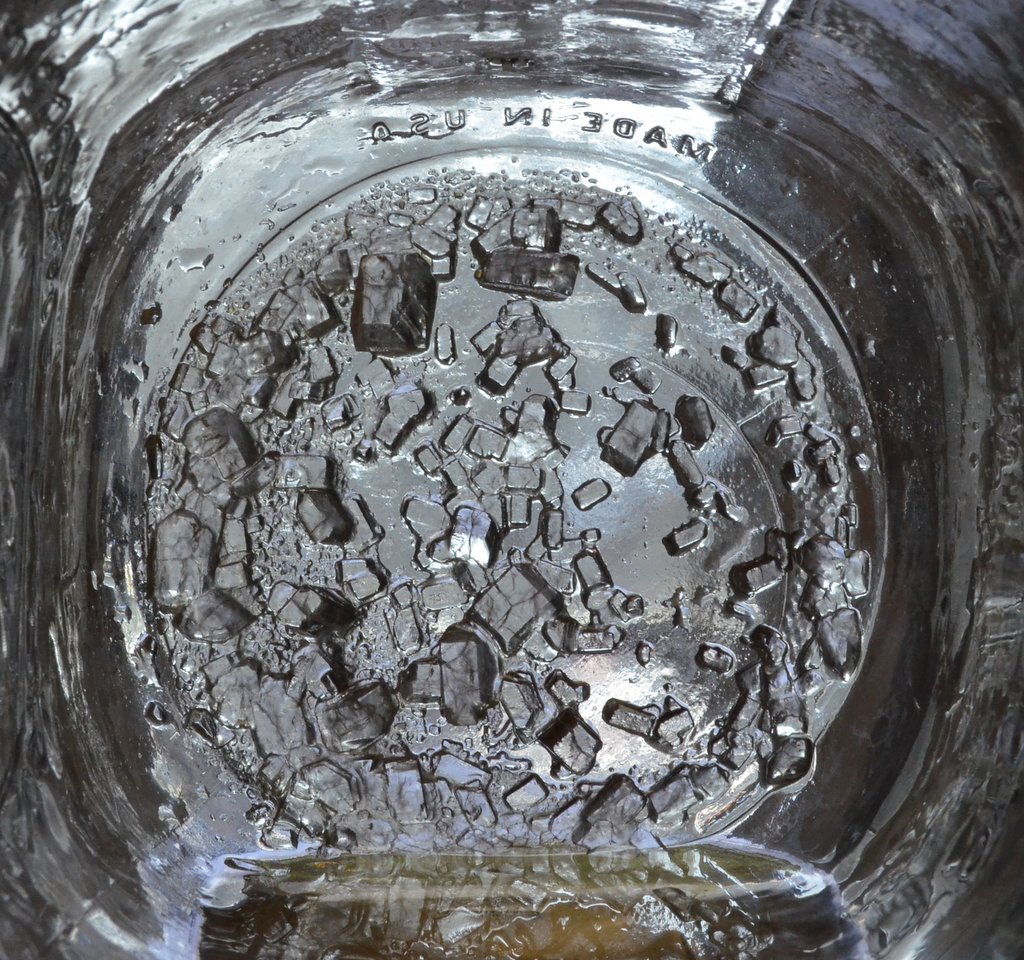
Sugar crystals are distinctly 4-sided, these from maple syrup
Square Sugar on Snow
A while back I was listening to the Geology Flannelcast, a brilliant (and most likely retired) podcast where 3 geologists explore different topics with wit and wisdom. On their episode about minerals, one of them in passing mentions that you can stand a salt shaker up on a pile of salt but not on a pile of sugar. But that didn’t jive with what I found in an old dried up jar of maple syrup, which had little cubes of sugar at the bottom. To figure out why I had to go back and listen to the podcast again (link).
A mineral is the building block of a rock, which can be made of 2 or more different minerals. So what is a mineral? To geologists an object has to have 5 properties to be a mineral proper:
- Solid
- Inorganic
- Naturally occurring
- Definite chemical composition
- Crystalline structure (orderly and repetitive)
And for each mineral, and there are more than 4500 so far described, each mineral has its own characteristic properties, such as:
- Color
- Streak (color of powder when rubbed against a plate with a hardeness of 7)
- Transparency
- Hardness (on Mohs Hardness Scale; a relative scale determined by which of 2 minerals when rubbed together scratches the other mineral, from diamond as the hardest to talc)
- Cleavage (how a mineral breaks down, can fracture along 1 plane to make sheets, or along more planes to make all sorts of shapes)
- Habit (the typical shape of the mineral, influenced by impurities, growing conditions)
- etc. (e.g. tenacity, luster, specific gravity, magnetism)
The most common mineral in earth’s crust is quartz, SiO4 (feldspars, NaAlSi3O8, KAlSi3O8, or CaAl2Si2O8, when taken as a single group are more abundant). It has a hardness of 7 of 10, is clear, but streaks white. And its habit is hexagonal (see image above), making those characteristic crystal prisms. It doesn’t cleave, but if fractured it makes a conchoidal shape (like a clam shell).
So back to that podcast. They mentioned how you could take a salt shaker and put it on salt but not sugar. The crystallized sugar at the bottom had formed all of these little rectangular prisms, which seemed like on a smaller scale would definitely make it possible to stand a salt shaker up on. So were they wrong or was I confused? Definitely me. The answer goes back to the characteristic property of a mineral. A mineral as it forms can have one shape but will cleave into another and fracture into a 3rd. I was looking at sugar aggregates, not table sugar.
Salt
When you buy salt, water has first been evaporated out and then it’s broken down into small, nearly uniform sized pieces. The shape of each grain results from its characteristic cleaving pattern, not its habit. Halite, NaCl, your typical table salt, cleaves along 3 planes, giving it a cubic structure.
Sugar
I couldn’t find details on this specifically, but it appears like the sugars in maple syrup have a cube habit. That is, as they aggregate they form cube-like structures, like what I found at the bottom of the jar. But if I ground these up into grains you’d find in a bag of sugar, they would have fractured into a much rounder shape. Therefore, it’s in the production process that they lose the shape I photographed, ultimately making it difficult to stand your salt shaker up in a pile of sugar. Mystery solved.
Sugar crystals are distinctly 4-sided, these from maple syrup
References
- How insects survive the cold: molecular mechanisms—a review (link)
-
Jumping mechanisms and performance of snow fleas (Mecoptera, Boreidae) (link)
- Cold jumpers (link)
- Â Overland Migration of Collembola (Hypogastrura nivicola Fitch) Colonies (link)
- Glycine-Rich Antifreeze Proteins from Snow Fleas (link)
- Bugs with bounce (link)
- Winter food of a small insectivorous bird, the golden-crowned kinglet (link)
- Insects attracted to Maple Sap: Observations from Prince Edward Island, Canada (link)




